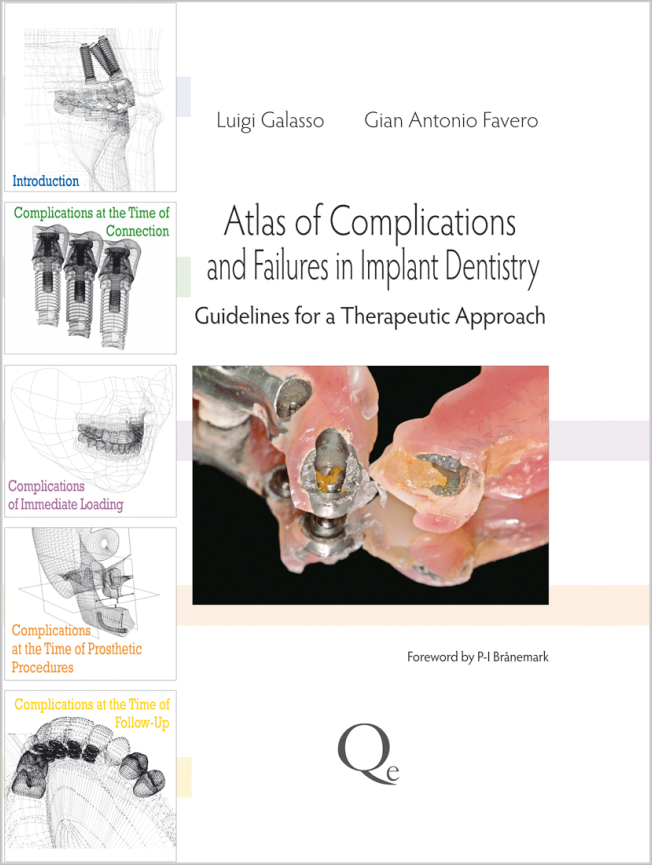Quintessence International, 10/2011
PubMed-ID: 22025999Seiten: 851-862, Sprache: EnglischSivolella, Stefano / Bressan, Eriberto / Gnocco, Elisa / Berengo, Mario / Favero, Gian AntonioObjective: To retrospectively analyze 14 consecutively treated cases of dental implants placed along with sinus lift procedures in patients with severe bone atrophy (residual bone height of 2 to 5 mm).
Method and Materials: Thirty-one implants were placed with a lateral window sinus lift in 14 patients using deproteinized bovine bone alone (no membrane) for the graft. The implants were monitored for a mean 43.20 ± 9.30 months (minimum, 25.00 months; maximum, 53.00 months) after placement and 32.40 ± 11.10 months (minimum, 11.40 months; maximum, 41.60 months) after fitting of the prostheses. The outcome measures evaluated were implant success, radiographic measurements (original alveolar bone height, peri-implant marginal bone loss, and relationship of implant apex to graft), implant-related probing pocket depth (PPD), Bleeding Index (BI), and prosthesis sucess.
Results: The implant success rate was 93.3%. The mean real alveolar bone height was 3.05 ± 0.87 mm, and there was evidence of peri-implant marginal bone loss (mean, 1.02 ± 1.40 mm). The relationship of implant apex to graft remained stable during follow-up. PPD was 5 mm in 91.6% of implants. The BI was 11.6%. The prosthetic success rate was 100%. Discussion: These findings indicate that dental implants can be employed successfully, even in conditions of severe bone atrophy, using only heterologous bone, provided suitable methods and materials are used (eg, site preparation, rough implant surfaces, and self-tapping screw implants).
Conclusion: The treatment described appears to afford acceptable results, with lower overall costs and treatment time.
Schlagwörter: bovine bone, simultaneous dental implant, sinus augmentation
The International Journal of Oral & Maxillofacial Implants, 6/1999
Seiten: 835-840, Sprache: EnglischPiattelli, Maurizio / Favero, Gian Antonio / Scarano, Antonio / Orsini, Giovanna / Piattelli, AdrianoMany materials are used for sinus augmentation procedures. Anorganic bovine bone (Bio-Oss) has been reported to be osteoconductive, and no inflammatory responses have been observed with the use of this biomaterial. One of the main questions pertaining to Bio-Oss concerns its biodegradation and substitution by host bone. Some investigators have observed rapid replacement by host bone, while other researchers observed slow resorptive activity or no resorption at all. The aim of the present study was to conduct a long-term histologic analysis of retrieved specimens in humans where Bio-Oss was used in sinus augmentation procedures. Specimens were retrieved from 20 patients after varying periods from 6 months to 4 years and were processed to obtain thin ground sections. Bio-Oss particles were surrounded for the most part by mature, compact bone. In some Haversian canals it was possible to observe small capillaries, mesenchymal cells, and osteoblasts in conjunction with new bone. No gaps were present at the interface between the Bio-Oss particles and newly formed bone. In specimens retrieved after 18 months and 4 years, it was also possible to observe the presence of osteoclasts in the process of resorbing the Bio-Oss particles and neighboring newly formed bone. Bio-Oss appears to be highly biocompatible and osteoconductive, is slowly resorbed in humans, and can be used with success as a bone substitute in maxillary sinus augmentation procedures.
Schlagwörter: anorganic bovine bone, biomaterials, sinus augmentation
The International Journal of Oral & Maxillofacial Implants, 5/1998
Seiten: 713-716, Sprache: EnglischPiattelli, Adriano / Scarano, Antonio / Balleri, Piero / Favero, Gian AntonioA new entity called implant periapical lesion has recently been described. This lesion could be the result of, for example, bone overheating, implant overloading, presence of a preexisting infection or residual root fragments and foreign bodies in the bone, contamination of the implant, or implant placement in an infected maxillary sinus. This case report describes a titanium implant that was placed in the maxillary premolar region. A fenestration involving the middle portion of the implant was present. After 7 months, the apical portion of the implant showed radiolucency. This lesion rapidly increased in size and a vestibular fistula appeared. A systemic course of antibiotics was not successful, and the implant was then removed. The histologic examination showed the presence of necrotic bone inside the antirotational hole of the implant. The etiology of the implant failure in this instance could possibly be related to bone overheating associated with an excessive tightening of the implant and compression of the bone chips inside the apical hole, producing subsequent necrosis.
Schlagwörter: bone necrosis, implant failure, titanium implant
The International Journal of Oral & Maxillofacial Implants, 3/1993
Seiten: 309-315, Sprache: EnglischPiattelli, Adriano / Cordioli, Gian Piero / Trisi, Paolo / Passi, Piero / Favero, Gian Antonio / Meffert, Roland M.An animal study was conducted with unloaded blocks and hydroxyapatite (HA)-coated titanium implants. Four HA blocks were positioned in rabbit tibiae and four HA-coated titanium implants were positioned in pig tibiae. Implants were positioned so that half was placed in cortical bone and half in medullary space. Biopsy specimens were taken 4 months after implant placement for histologic evaluation. Light microscopy and confocal laser scanning microscopy demonstrated that the HA resorption rate was higher in the medullary spaces, whereas resorption was almost absent in the areas embedded in cortical bone.
Schlagwörter: cortical bone, hydroxyapatite, medullary bone, resorption




